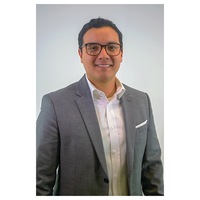Jorge Alberto Arriaga
Universidad Nacional Autónoma de México, Red del Agua UNAM, Department Member
Research Interests:
Research Interests: Calidad De Agua, Calidad Del Agua, Contaminación del Agua, ABASTECIMIENTO DE AGUA, Abastecimento De água, and 7 moreValor costo y tarifas del agua, Proyecciones De Demandas De Agua, Tratamiento De Aguas Residuales, Comparación de las tarifas de agua potable en las principales ciudades de Latinoamérica, Gestión Integrada Del Agua, Conservacion De Suelo Y Agua, and Ciencia Ciudadana
Research Interests:
Research Interests:
Research Interests:
Research Interests:
Research Interests:
Research Interests:
Research Interests:
Research Interests:
Para solventar la crisis del agua que vive el país, entre 78 y 81 por ciento de los mexicanos tienen que invertir de cinco a 10 por ciento de sus ingresos para comprar el líquido embotellado para su consumo cotidiano. De hecho, 86 por... more
Para solventar la crisis del agua que vive el país, entre 78 y 81 por ciento de los mexicanos tienen que invertir de cinco a 10 por ciento de sus ingresos para comprar el líquido embotellado para su consumo cotidiano. De hecho, 86 por ciento de la población no tiene acceso al agua las 24 horas del día y, como todo problema social, los más pobres resultan ser los más afectados, principalmente en estados como Oaxaca, Puebla y Tlaxcala.
Research Interests:
Research Interests:
Research Interests:
Research Interests:
Research Interests:
As knowledge society is mainstreaming around the world, Information and Communication Technologies (ICT) have been increasingly integrated in formal and informal leaning environments, especially in a complex and fast-changing reality. In... more
As knowledge society is mainstreaming around the world, Information and Communication Technologies (ICT) have been increasingly integrated in formal and informal leaning environments, especially in a complex and fast-changing reality. In this context, Learning and Knowledge Technologies (LKT) have proved to be a valuable asset for continuous learning of professional from all sectors, especially for those working on natural resources management and the governance of common goods, since science and technology related to these topic are rapidly moving forward and paradigms are changing in a fast-pace. The water sector is not the exception. Water resources management requires a specific set of skills that are not only oriented towards engineering and technical studies, but also requires the understanding of social and biological dynamics, all of them working together in a complex system. Due to the transdisciplinary approach and the constant changes in the area, water professionals are actively demanding new ways to increase their knowledge through virtual learning environments. This paper analyses the experience of the National Autonomous University of Mexico (UNAM), with the collaboration of the Regional Centre for Water Security (CERSHI) under the auspices of UNESCO, in designing and implementing the Massive Open Online Course (MOOC) on Water Security, available on Coursera platform. Firstly, the document presents the changes of paradigms in water management and explores how the water sector has incorporated them into its educational programs and trainings. Then, the phases of designing the MOOC are described, considering the identification, selection and analysis of formal education programs on water security, both nationals and internationals, as well as the integration of the syllabus under a frontier science approach. The development of the virtual learning environment is also discussed in this section. Finally, the capacity of this initiative to promote education for sustainability in Latin America and the Caribbean as well as community engagement and youth participation in integrated water resources management is discussed.
Research Interests:
Research Interests:
Research Interests:
The most important impacts of climate change will be exerted on water resources. In Mexico, due to environmental conditions, human factors, and water uses, different degrees of social vulnerability will take place because of the increased... more
The most important impacts of climate change will be exerted on water resources. In Mexico, due to environmental conditions, human factors, and water uses, different degrees of social vulnerability will take place because of the increased temperature, decreased precipitation, and higher recurrence of extreme events projected to take place in the second half of the twenty-first century. Based on these considerations, this chapter presents the case study of the Grijalva River basin, the largest dam system used for hydropower generation in Mexico. Using temperature and precipitation scenarios, the impacts of climate change on sea level rise, the production of electricity, and water quality and availability are analyzed. Finally, it presents some adaptation measures that contribute to reduce the vulnerability of societies living in the Grijalva River basin.
